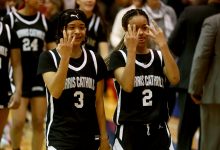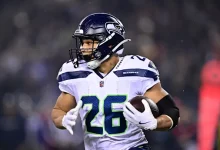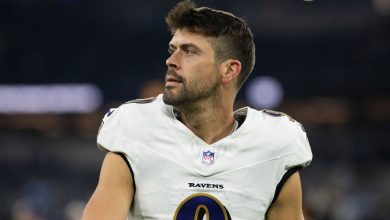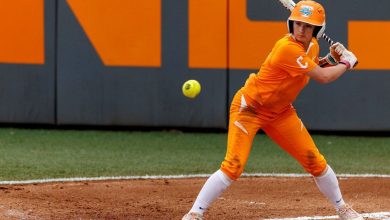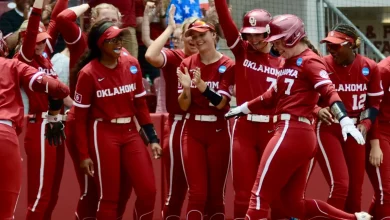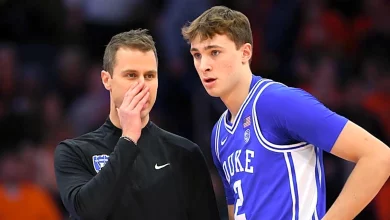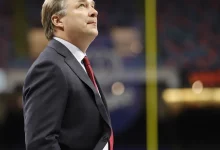Biggest Notre Dame question mark still must be answered despite an incredible 2026 recruiting run for the Fighting Irish
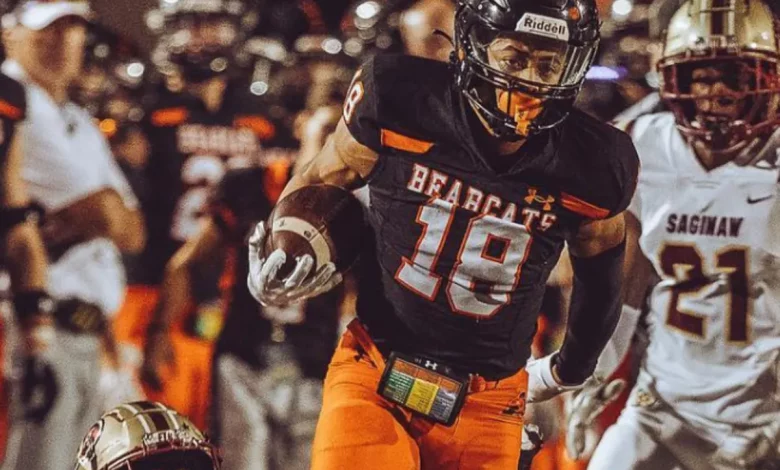
Biggest Notre Dame question mark still must be answered despite an incredible 2026 recruiting run for the Fighting Irish
Notre Dame football is on quite the 2026 recruiting hot streak recently. They earned a commitment from dynamic four-star running back Jonaz Walton on Wednesday, but that isn’t even their biggest get over the last several weeks. Other names to jump on board recently include five-star defensive end Rodney Dunham, toolsy pass rusher Ebenezer Ewetade, and fellow star runner Javian Osborne among others.
If you are a Fighting Irish fan right now, you should be flooded with excitement for the current state of the Notre Dame program, and the future. The talent that head coach Marcus Freeman and his staff are bringing in is tremendous as a whole. Outside of that general excitement, there is still one position group that has some major questions to answer on the recruiting trail this cycle, the wide receivers.
Heading into the 2026 recruiting class, some grace was given to wide receiver coach Mike Brown, and it was justified. He walked into a difficult situation, and a run centric offense that doesn’t typically attract big-time pass catchers. That made the 2025 class more of a test period, but was ultimately a pass as he got his feet wet in recruiting with the Notre Dame program.
While there is a ton of momentum on the recruiting trail, a lot of Notre Dame fans wait patiently for the dynamic wide receivers to commit to this class. The Irish got an early commitment from Florida standout Dylan Faison, but due to his family ties to the program, it wasn’t exactly the most difficult pull. The other wide receiver commit in the class is Georgia athlete Bubba Frazier, a talented space weapon, but once again, not the headliner of a wide receiver class.
The biggest issue with feeling confident about the 2026 wide receiver group is that it isn’t a very big target board right now, and it doesn’t feel like a foregone conclusion that Notre Dame is going to find a difference maker. I like where they are with former USC commit Kohen Brown, but he is a developmental speed receiver who is appropriately ranked as a three-star player right now. Some like their standing with Texas standout Brayden Robinson right now, but the diminutive slot is still taking a long look at Miami. I’m not ready to declare him Irish as of right now.
Really the only true difference maker on the board of realistic targets as things stand right now is Aledo (Texas) High School wide receiver Kaydon Finley. The 6-0, 200-pound pass catcher is one of the more productive wide receivers in the class, having hauled in 81 receptions for 1,432 yards and 21 touchdowns last year in a strong classification of high school football. The Irish have been high on Finley for some time, and continue to battle the Texas Longhorns and Texas A&M Aggies for his services.
Notre Dame is certainly in the running, but the optimism is starting to stagnate right now. Finley has deep Texas ties with his father Jermichael Finley starring ay tight end for the Longhorns, and the allure to keep him in the Lone Star State is strong right now around him. The longer this recruitment plays out, I think the worse it is for Notre Dame. If the program does miss on Finley, I’m worried about the completeness of the class. Would a hypothetical class of Robinson, Faison, Frazier, and Brown be bad?
No, there would be a lot to like there. The problem is that is much more of a developmental class than you would like, especially after having much of the same in 2025. That just wouldn’t answer the questions surrounding Coach Brown’s abilities as a recruiter, at least not for the high end targets.
Like it or not, Coach Brown is the weak link of the staff right now in terms of recruiting. Coach Freeman is a dynamic recruiter, as is secondary coach Mike Mickens. Joe Rudolph has attracted several outstanding offensive lineman the last couple of years, while defensive line coach Al Washington has answered a ton of questions.
Despite an impressive and highly successful recruiting run in 2026, Notre Dame’s most significant question mark remains unresolved, casting a shadow over an otherwise promising future for the Fighting Irish. This lingering uncertainty centers around the team’s ability to translate their recruiting prowess into sustained on-field success, especially in high-stakes games and national title pursuits. While the 2026 recruiting class has generated excitement and optimism, the true measure of Notre Dame’s future will depend on how effectively they develop these talents, address positional needs, and navigate the competitive landscape of college football. This comprehensive analysis explores the context of Notre Dame’s recruiting surge, the specific question marks that persist, the factors influencing this uncertainty, and what the future might hold for the storied program.
**The 2026 Recruiting Surge: A Bright Spot**
Notre Dame’s recruiting class of 2026 has been widely regarded as one of the best in recent history for the program. Under the leadership of head coach Marcus Freeman, the Irish managed to secure commitments from top-tier prospects across multiple positions, including elite quarterbacks, offensive linemen, linebackers, and defensive backs. This recruiting haul has been celebrated for its quality and depth, promising to bolster Notre Dame’s roster for years to come.
The success in recruiting reflects a combination of factors: Freeman’s rising stature as a recruiter, the Irish’s storied tradition and national appeal, strategic targeting of high-potential prospects, and their ability to outmaneuver traditional powerhouses in the recruiting battles. The class’s strength has generated hope among fans and analysts that Notre Dame is poised to return to its former national prominence, capable of competing with the best teams in the country.
**The Persistent Question Mark: Development and Performance**
However, despite the optimism surrounding the recruiting class, the biggest question mark for Notre Dame remains: can the program develop these talented players into elite performers capable of winning big games? Recruiting rankings are an important indicator of future potential, but they do not guarantee success on the field. History has shown that programs can stockpile highly rated classes yet still struggle to translate that talent into consistent victories, especially against top-tier opponents.
Notre Dame’s past performances highlight this concern. While the Irish have enjoyed successful seasons and notable victories, they have often fallen short in marquee games—particularly against playoff-caliber teams—raising doubts about their ability to close out championships. The challenge lies in player development, coaching adjustments, and managing the pressures of high-stakes contests. The transition from high school dominance to college excellence is complex, requiring not only talent but also mental toughness, depth, adaptability, and coaching acumen.
**Key Areas of Uncertainty**
Several specific areas contribute to Notre Dame’s lingering question mark:
1. **Quarterback Development:** The quarterback position is vital for any team’s success, and Notre Dame’s future hinges on whether their new signal-callers can elevate the offense. While recruiting has brought in promising prospects, the transition to college football’s speed and complexity can be daunting. The Irish need a consistent, high-performing quarterback to unlock their offensive potential, and whether their current or future quarterbacks can meet that standard remains uncertain.
2. **Offensive Line and Line of Scrimmage:** The Irish’s success often depends on dominance at the line of scrimmage. The 2026 class has provided reinforcements, but developing offensive and defensive lines to match the physicality of elite programs takes time. If Notre Dame’s line struggles against top defenses, it could limit their offensive explosiveness and defensive resilience.
3. **Defensive Consistency:** While Notre Dame has traditionally been known for stout defenses, recent seasons have seen fluctuations in defensive performance. The new recruits need to adapt quickly and contribute immediately. If the defense cannot sustain pressure or limit high-powered offenses, the Irish’s chances in big games diminish.
4. **Coaching and Tactical Adjustments:** Developing talent is one aspect; coaching adjustments during games and strategic planning are equally critical. The Irish have made strides under Freeman, but the ultimate test is whether their coaching staff can adapt to diverse offensive schemes and contain high-caliber opponents in critical moments.
5. **Culture and Mental Toughness:** College football success is often dictated by mental resilience, especially in tight games or postseason scenarios. Whether Notre Dame’s players and coaching staff can foster a culture of perseverance and focus is an ongoing question that impacts their ability to win in high-pressure environments.
**High Expectations vs. Reality**
The 2026 recruiting run has set high expectations for Notre Dame, fueling hopes of a return to national championship contention. However, history suggests that recruiting alone does not guarantee success. Many highly ranked classes have underperformed relative to expectations due to development gaps, coaching issues, or simply the unpredictability of the sport.
Notre Dame’s challenge is to convert their recruiting advantage into tangible results—winning playoff games, competing for national titles, and establishing a consistent presence among college football’s elite. Until they demonstrate the ability to perform under pressure and secure crucial victories, the question mark will persist.
**The Broader College Football Landscape**
Adding to the uncertainty is the highly competitive and evolving landscape of college football. Powerhouse programs like Alabama, Georgia, Ohio State, and Clemson continue to recruit at an elite level and have established winning cultures. Notre Dame must not only develop their talent but also navigate this fierce competition, maintain recruiting momentum, and adapt tactically.
Furthermore, the changing landscape of college athletics—such as the transfer portal, NIL (Name, Image, Likeness) deals, and conference realignments—introduces additional variables. The Irish must manage roster stability, player motivation, and resource allocation effectively to sustain their competitive edge.
**What Needs to Happen for the Question Mark to Be Answered**
To resolve the lingering uncertainty, Notre Dame must focus on several key areas:
– **Player Development:** Prioritize coaching that accelerates the growth of their talented recruits, ensuring they can contribute meaningfully early in their careers.
– **In-Game Adaptability:** Foster tactical flexibility to adjust to diverse offensive and defensive schemes, especially in high-stakes games.
– **Mental Toughness:** Cultivate a resilient team culture that thrives under pressure and performs consistently against top opponents.
– **Recruiting and Retention:** Continue to attract top talent and retain key players, maintaining their competitive advantage.
– **Results on the Field:** Ultimately, the proof will be in the wins—particularly in critical games against playoff contenders and in postseason play.
While Notre Dame’s 2026 recruiting class represents a bright beacon of hope, the program’s biggest question mark remains whether they can transform this potential into sustained success at the highest levels of college football. The journey from recruiting dominance to national championship contention is complex and fraught with challenges, including player development, coaching adjustments, and the unpredictable nature of the sport. Until the Irish demonstrate their ability to win critical games and compete consistently with the sport’s best, this question mark will continue to loom. Nonetheless, the recruiting success provides a solid foundation, and with strategic development and execution, Notre Dame can hope to turn their recruiting promise into a new era of national prominence.

